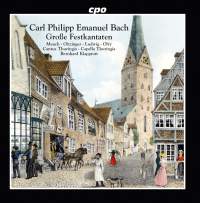Texte paru dans: / Appeared in: |
|
|
Outil de traduction ~ (Très approximatif) |
|
|
Reviewer: Bertil
van Boer
This is another in a series of
live recordings of some of the rarer festival cantatas by Carl Philipp
Emanuel Bach, in honor of his 300th birthday in 2014. There is extensive
sponsorship indicated on the disc produced by CPO, ranging from the Leipzig
Bach Archiv to the Thuringian state cultural arm. Both of these works were
not known to Wotquenne, but the autographs were part of the Berlin
Singakademie archives that resurfaced in Kiev upon the break-up of the
Soviet Union almost 30 years ago and were repatriated to Germany. They form
part of the myriad of cantatas that Bach was obliged to write rapidly for
special events or occasions above and beyond his normal compositional duties
for the city of Hamburg. Not even his Herculean efforts were enough in this
regard, so he opted to cobble together music by other composers of the day.
Both of these date from 1771, when he was required to deliver specialized
works: the first, Ich will dem Herrn lobsingen, for the investiture of the
pastor at the Michaelkirche in November of that year; and the second, Wer
sich rühmen will, for the same ceremony in 1787 at the Peterskirche. As
these were above and beyond his normal duties, they had to be of a
particularly festive nature, with multiple woodwinds, a trio of clarino
trumpets, and timpani to lend color and pomp to the circumstances. In typical festive C. P. E. fashion, the first cantata opens with a brilliant chorus, all flashing trumpets and drums to the final word “Halleluja.” The following aria (after the usual recitative) is simpler in context, starting right out without an orchestral introduction. Here one is reminded of Telemann’s late works, with a good lyrical line and dotted French rhythms, not to mention the harmonically challenging transitions. The next aria, following the usual straightforward chorale setting and recitatives, features a pair of gentle flutes, with the soprano line hesitantly interjecting small motivic phrases before her ornamented line stabilizes. Without warning, a faster section is interpolated before a return to the softer flute da capo. This in turn contrasts with the tenor aria accompanied by a clarion trumpet call, more of a punctuation than a true solo. Still, several of the licks are at the top of the range, emphasizing its brilliance. The chorale “Sei Lob und Preis und Ehr” ought really to be a conclusion to the cantata with the addition of the trumpet choir, but it only serves as a way station to a second part. Here, the aria “Sei fromm, mein Sohn” is pensive, with muted strings and a contrabass pizzicato; the organ is proscribed here to provide a requisite tonal softness. The chorus “Wir wollen Jesu Lehren preisen” is suitably gigue-like in compound meter, with an internal solo line by the soprano accompanied by the oboes and a powerful, conclusive full ensemble ending. Bach liked it well enough to repeat it after the concluding chorale. For the second cantata, written shortly before his death, Bach relied on works by Georg Anton Benda, a colleague from Berlin who was resident in Gotha (and to whom he sent compositions now and again). The work opens with a brief recitative, like the admonitory voice of God, but immediately thereafter the expected chorus of praise replete with full brass occurs. This, alas, happens to be the high point of this work. The remaining choral portions are somewhat pedestrian chorales, though there is one chorus, “Deine Gebote erleuchten die Seele,” which floats along with a unison string accompaniment in the ritornello sections. As for the solo portions, these are mostly recitatives and short ariosos, with two exceptions. The first, a quartet, “Dein sanftes Wort der Gnade,” has the softer double reeds accompanying the voices in a rather mournful and pensive aria. Bach pairs his female and male soloists to provide the necessary timbral contrast. It too is relatively short, but the final aria for the bass, “Tritt hin,” is more operatic, with a long and elaborate solo oboe and more virtuoso vocal line. Of the two cantatas, the first outshines the second, but both are expertly composed, a feat considering the occasional nature of the commissions. As for the performance, the Capella Thuringia (and its vocal component the Cantus) are adept at this sort of style, bringing to it a fine sense of nuance. It is marketed as a live recording, but one would be hard put not to think of it as a studio piece. The microphone placement may have something to do with it in the Thomaskirche in Leipzig, but the balance of the ensemble itself contributes a great deal to the ambience. All four of the soloists are equally adept at the cantata style, performing with clarity and precision. Bernhard Klapprott keeps the tempos graceful, allowing the finer stylistic points to emerge. All in all, this is an excellent recording and is something that collectors of C. P. E. Bach ought to have in their collection. | |
|
Support us financially by purchasing this disc from eiher one of these suppliers. Un achat via l'un ou l'autre des fournisseurs proposés contribue à défrayer les coûts d'exploitation de ce site. |
|
|
|
|
|
Cliquez l'un ou l'autre
bouton pour découvrir bien d'autres critiques de CD |
|




